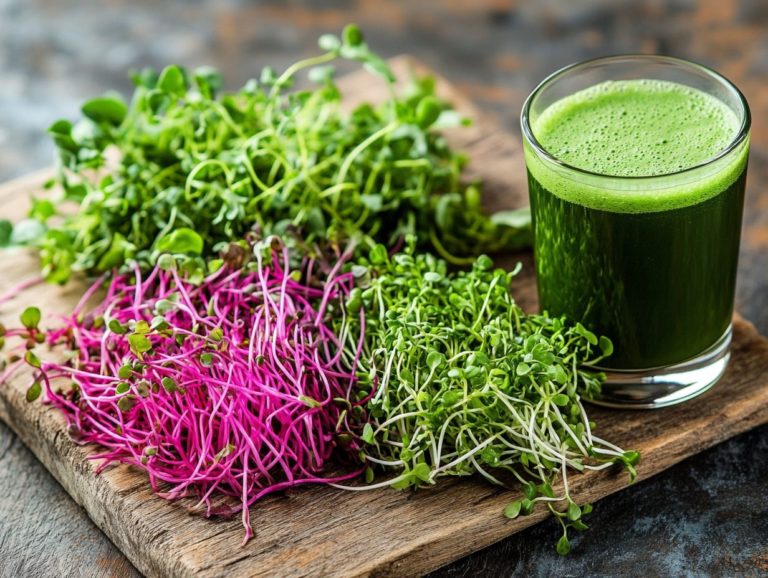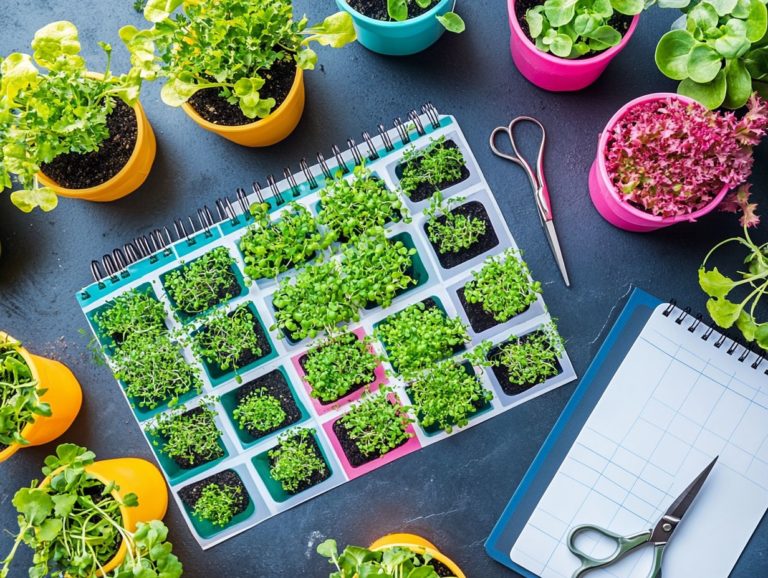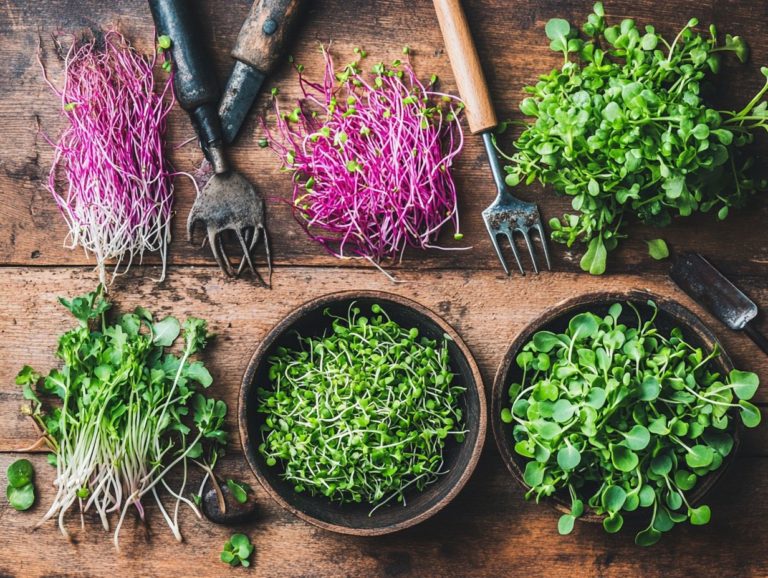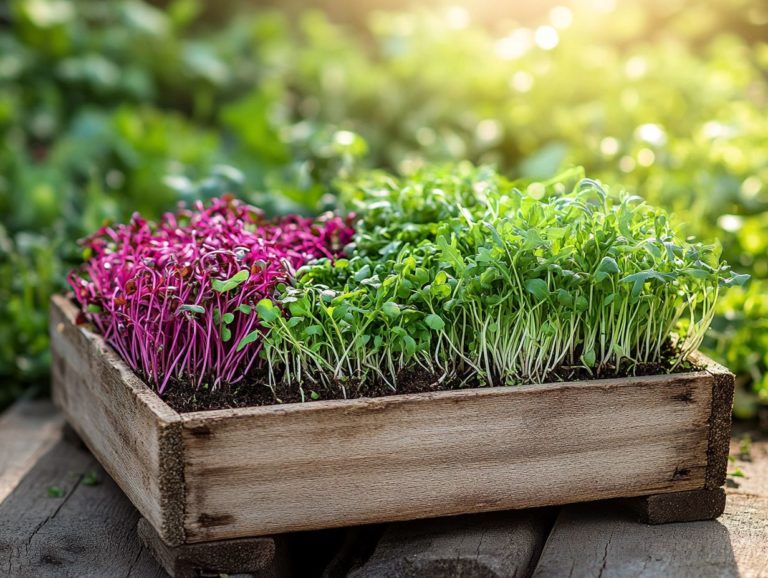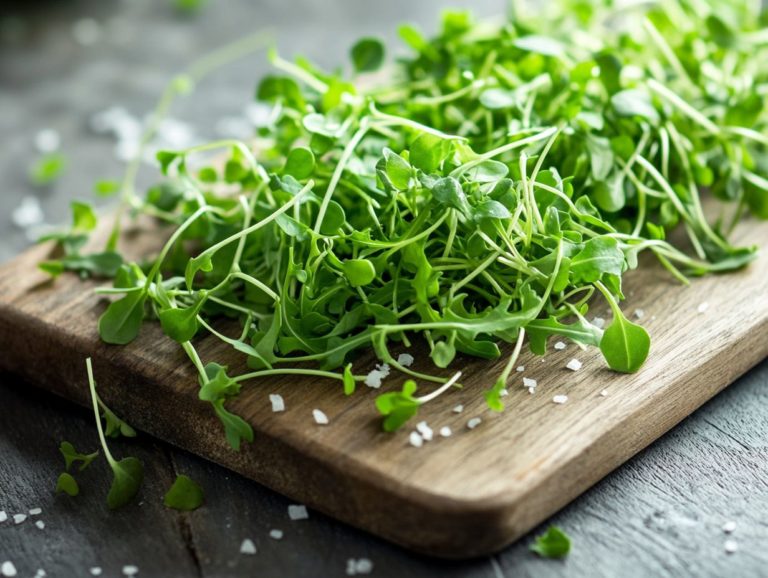How to Blend Microgreens into Dishes?
Microgreens are not just tiny greens; they are little powerhouses of flavor and nutrition, making them a top choice for anyone who values health in their dining experience.
This article delves into the remarkable benefits of incorporating microgreens into your meals, showcasing their impressive nutritional profile and the unique flavors they can add to your dishes.
It offers insights into various types of microgreens and provides practical tips on how to prepare, store, and creatively incorporate them into your cooking ideas.
This article addresses food safety concerns, ensuring you can enjoy these vibrant greens with peace of mind.
Get excited to elevate your dishes with these amazing greens!
Contents
- Key Takeaways:
- Benefits of Incorporating Microgreens into Dishes
- Nutritional Value and Flavor Enhancements
- Types of Microgreens
- How to Prepare Microgreens for Use
- Creative Ways to Use Microgreens in Dishes
- Potential Risks and Precautions
- Frequently Asked Questions
- 1. How can I incorporate microgreens into my dishes?
- 2. Can I blend microgreens into my sauces or dressings?
- 3. What are some popular dishes that use blended microgreens?
- 4. How do I preserve the freshness of blended microgreens?
- 5. Are there any specific varieties of microgreens that are best for blending into dishes?
- 6. Can I blend different types of microgreens together?
Key Takeaways:
- Microgreens are young, nutrient-rich greens that can add flavor and nutritional value to dishes.
- There are many types of microgreens, including popular varieties like broccoli and pea shoots.
- To incorporate microgreens into dishes, clean and store them properly, and get creative with recipe ideas.
What are Microgreens?
Microgreens are your secret weapon in the culinary world young, edible plants harvested just after the first true leaves that are bursting with flavor and nutrients. They re the perfect way to elevate a range of dishes, from fresh salads and hearty soups to gourmet sandwiches and wraps. Imagine the delightful crunch of pea shoots or the zesty kick from radish microgreens, alongside a medley of other herbs and vegetables. These tiny greens not only enhance your meals but also provide essential vitamins and minerals.
The beauty of growing microgreens lies in their simplicity. They require minimal space and time, often sprouting in as little as seven to fourteen days. With a plethora of varieties available, both chefs and home cooks appreciate their versatility, seamlessly incorporating them into numerous culinary applications. Nutritionally speaking, these greens can have up to 40 times more nutrients than regular vegetables.
Integrating microgreens into your meals is a breeze. Consider:
- Sprinkling them over salads for crunch,
- Blending them into soups for depth, or
- Layering them in sandwiches for flavor.
Each variety brings its unique taste and health benefits, making microgreens a must-have for the health-conscious and food enthusiasts alike.
Benefits of Incorporating Microgreens into Dishes
Incorporating microgreens into your dishes offers a wealth of benefits, enhancing both flavor profiles and nutritional content while inviting you to explore your culinary creativity in salads, soups, and more. These petite greens not only make your meals look more inviting but also deliver a robust blend of vitamins, minerals, and antioxidants crucial for a balanced diet.
By integrating microgreens such as basil, radishes, and pea shoots into your recipes, you can significantly elevate the taste and health quotient of your meals, transforming them into delightful and nourishing experiences.
Nutritional Value and Flavor Enhancements
Microgreens are your secret weapon in the kitchen, celebrated not only for their vibrant flavors but also for their impressive nutritional punch. These tiny greens are brimming with a diverse array of vitamins and minerals that can enhance the healthfulness of your favorite recipes. Research shows that microgreens often pack more nutrients than their fully grown counterparts, making them a brilliant addition to your diet.
By incorporating microgreens into salads, soups, sandwiches, and other dishes, you can enjoy a flavorful boost while nourishing your body with essential nutrients.
These greens are loaded with vitamins A, C, E, and K, along with minerals like calcium, potassium, and magnesium. They play a crucial role in supporting immune health and promoting strong bones. Microgreens also aid in wound healing. For example, adding arugula microgreens brings a peppery kick to your avocado toast. In contrast, basil microgreens elevate a classic caprese salad with their delightful aromatic essence.
Microgreens do more than boost flavor; their nutritional density the amount of nutrients packed into a small serving means that even a small sprinkle can significantly elevate the vitamins in your meal. They re not merely a garnish; they re a powerhouse of health benefits waiting to transform your dining experience.
Types of Microgreens
Get ready to explore a fantastic range of microgreens, each presenting its own unique flavor profile and cooking possibilities. These tiny powerhouses serve as versatile ingredients for salads, wraps, and various recipes.
Consider popular varieties like basil, radishes, and pea shoots. Each one contributes its distinct taste and texture to your dishes. By familiarizing yourself with these microgreens, you can make informed choices about which to incorporate into your meals, elevating both flavor and presentation while reaping their nutritional rewards.
Popular Varieties and Their Uses
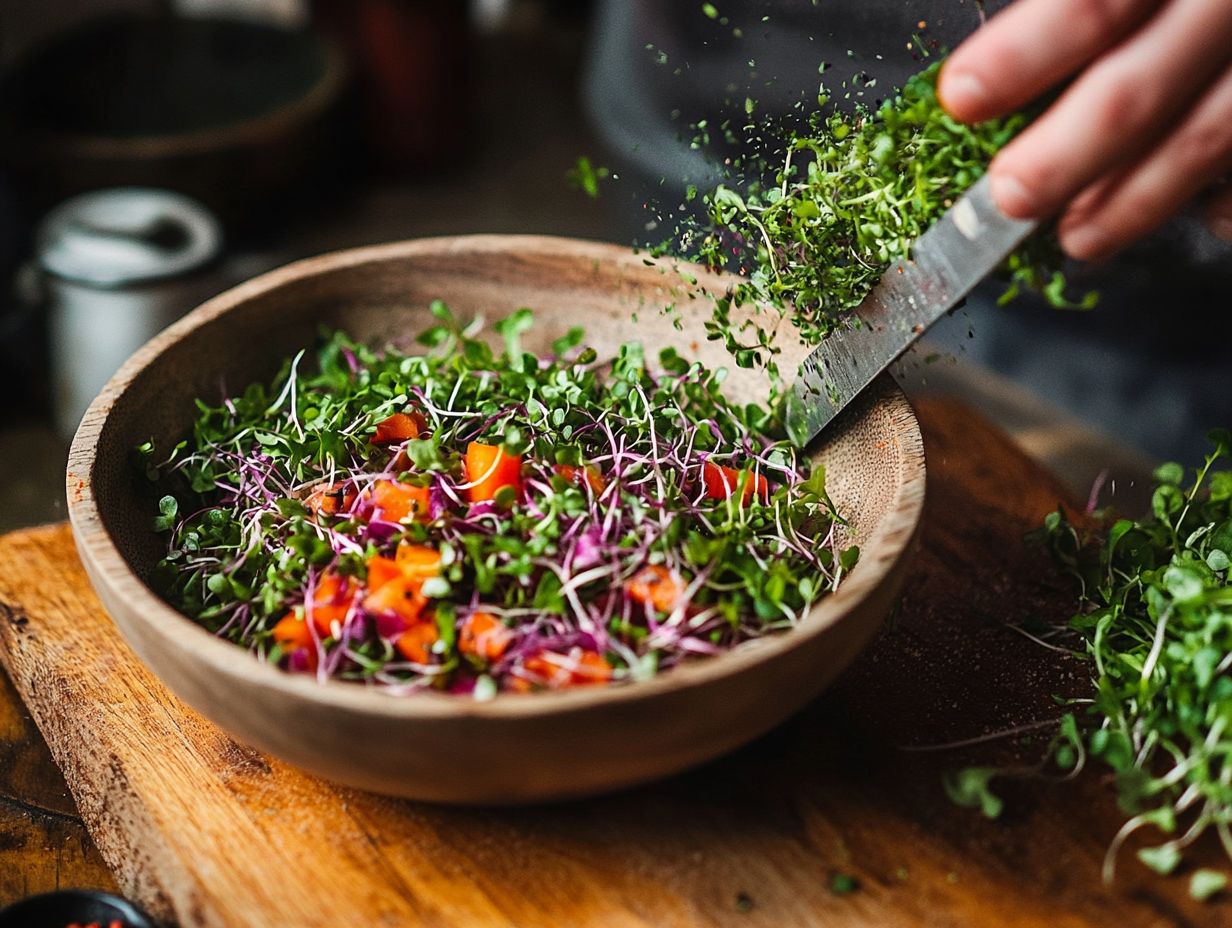
Among the most popular microgreens, you’ll find varieties like basil, radishes, and pea shoots, each boasting distinct flavors and versatile ways to use them in your cooking.
These tiny greens do more than just elevate the taste of a dish; they add a splash of color and nutrition too. For example, when you mix basil microgreens into a lively herb-infused vinaigrette, you’re not just dressing roasted vegetables you’re transforming a simple side into a gourmet delight.
The zesty bite of radish microgreens can take humble avocado toast and turn it into a culinary sensation, offering both texture and a delightful kick. Meanwhile, pea shoots, with their delicate tendrils, are perfect for any fresh spring roll, bringing a layer of sweetness that beautifully balances the savory elements.
Incorporating these microgreens into your everyday meals is an effortless way to unlock a whole new dimension of flavor. Discover ways to enhance flavor in microgreens and don’t wait! Start adding microgreens to your dishes today for an instant flavor upgrade.
How to Prepare Microgreens for Use
Properly preparing microgreens is crucial for preserving their flavor and nutritional benefits. Begin by rinsing the microgreens under cold water to eliminate any soil or debris. After that, gently pat them dry with a clean towel.
Storage is equally important. By placing them in a breathable container in the fridge, you ll ensure they stay fresh and ready to enhance a variety of dishes, from salads and smoothies to elegant garnishes.
Cleaning and Storing Tips
Cleaning and storing microgreens properly is essential for preserving their freshness and flavor. This significantly elevates the quality of your dishes.
Start by rinsing the microgreens under cool water, gently washing away any dirt or debris. To dry them effectively, use a salad spinner or lay them out on a clean towel.
For storage, place the cleaned microgreens in a container lined with a damp paper towel. Keep them in the refrigerator to ensure they remain crisp and ready for your salads, soups, and wraps.
Plus these steps, handle microgreens with care, as their delicate leaves can bruise easily. Use scissors to trim the roots before washing to preserve the structure of the greens.
Ideal tools for this process include:
- A gentle brush for getting into crevices
- A colander for easy rinsing
When handled properly, these microgreens not only look appealing but also offer enhanced flavors. They make a fantastic addition to gourmet sandwiches, vibrant pestos, and colorful grain bowls.
Stored correctly, these nutrient-dense greens can last for days. This streamlines your meal prep and keeps your culinary creations fresh and exciting.
Creative Ways to Use Microgreens in Dishes
Microgreens add a delightful touch to many dishes, providing flavor and nutrition along with vibrant visual appeal.
Picture your salads, soups, breakfast creations, pizzas, and tacos topped with these vibrant greens. You can also blend them into smoothies and wraps for added versatility.
With a few simple recipe ideas, you can easily incorporate these miniature powerhouses into your diet, enriching your meals while enjoying their numerous health benefits.
Recipe Ideas and Tips
Regarding recipe ideas, microgreens present a world of possibilities. They can enhance salads, sandwiches, or even smoothies with a nutrient-packed punch.
**Refreshing Salad**: Combine microgreens with an array of vegetables and drizzle on a light dressing.
**Morning Smoothie**: Add them to your smoothie for a surprising twist that boosts both taste and health benefits.
**Tacos and Soups**: Use them as a delightful garnish to elevate presentation.
**Omelets and Scrambled Eggs**: Inject a vibrant burst of color and nutrients.
**Homemade Pesto**: Blend them into pesto for a distinctive spread that pairs beautifully with crusty bread or roasted vegetables.
When crafting a sandwich, layer microgreens between your favorite proteins and spreads to create a gourmet experience.
**Stir-Fries and Grain Bowls**: Saut them lightly to add depth and showcase their remarkable versatility across cuisines.
Potential Risks and Precautions

While microgreens are typically safe and packed with nutrition, be aware of potential risks concerning food safety and health.
Like any fresh produce, microgreens can carry bacteria if not handled with care, which could lead to foodborne illnesses.
To minimize these risks, wash microgreens thoroughly and purchase them from reputable sources.
By taking these steps, you can enjoy all the health benefits they offer without compromising on safety.
Try these tips today and bring vibrant microgreens into your meals!
Food Safety Concerns
Microgreens can harbor bacteria if not handled properly. Source them from trusted suppliers and ensure they are fresh and free of spoilage.
Wash them thoroughly with clean water to get rid of any surface bacteria. This simple step helps you enjoy them safely.
Always use clean utensils and cutting boards to prevent mixing bacteria from different foods. Store microgreens in a cool, dry place to keep them fresh.
Refrigerate them until just before serving to reduce the risk of bacteria growth.
These easy practices not only make microgreens safer but also enhance their vibrant flavors and health benefits.
Final Thoughts and Recommendations
Microgreens are not just trendy; they are a nutritious powerhouse for your meals. Their vibrant flavors and impressive nutrients can boost your overall health.
Use them to enhance salads, smoothies, and sandwiches. They add a delightful crunch and burst of flavor to stir-fries, soups, and more!
Microgreens grow quickly and need little space, so anyone can grow them year-round, even in small apartments.
Experiment with varieties like arugula, radish, or basil. Each offers unique flavors and can make your dishes visually appealing.
Frequently Asked Questions
1. How can I incorporate microgreens into my dishes?
Mix microgreens with your salads, smoothies, or omelettes. You can sprinkle them on top of your main dishes for added nutrition and flavor.
2. Can I blend microgreens into my sauces or dressings?
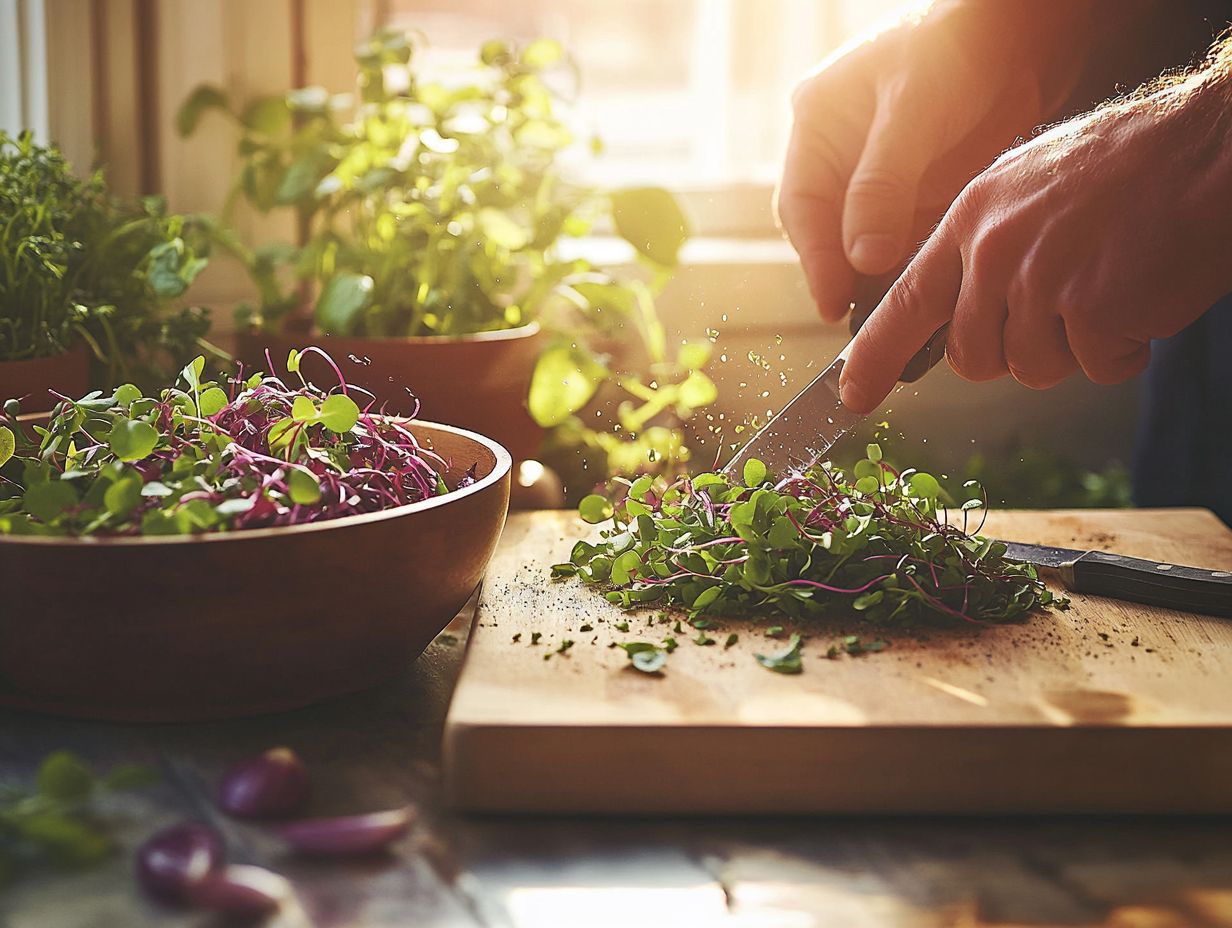
Absolutely! Microgreens can supercharge your sauces and dressings with nutrients and flavor. Just chop them finely and mix!
3. What are some popular dishes that use blended microgreens?
Some popular dishes that use blended microgreens include pesto, green smoothies, and microgreens hummus. Don t miss out on using them in your soups or stir-fries for an extra flavor kick!
4. How do I preserve the freshness of blended microgreens?
To preserve the freshness of blended microgreens, store them in an airtight container in the refrigerator. They should stay fresh for up to 5 days.
5. Are there any specific varieties of microgreens that are best for blending into dishes?
While all microgreens can be blended into dishes, some popular choices include broccoli, kale, and pea shoots for their mild and versatile flavors.
6. Can I blend different types of microgreens together?
Yes, you can experiment with blending different types of microgreens together to create unique and flavorful combinations. Just make sure to adjust the amount of each microgreen used to balance the flavors.

